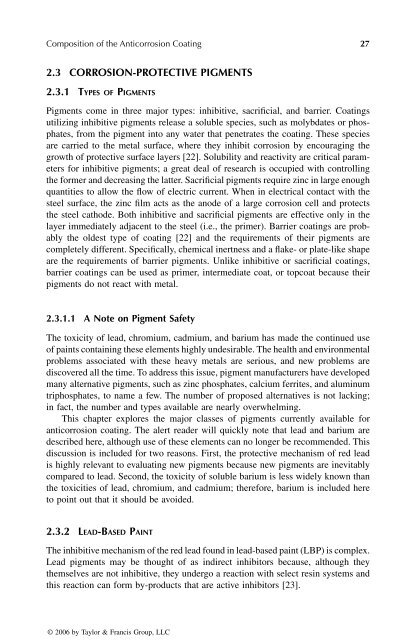© 2006 by Taylor & Francis Group, LLC
© 2006 by Taylor & Francis Group, LLC
© 2006 by Taylor & Francis Group, LLC
You also want an ePaper? Increase the reach of your titles
YUMPU automatically turns print PDFs into web optimized ePapers that Google loves.
Composition of the Anticorrosion Coating 27<br />
2.3 CORROSION-PROTECTIVE PIGMENTS<br />
2.3.1 TYPES OF PIGMENTS<br />
Pigments come in three major types: inhibitive, sacrificial, and barrier. Coatings<br />
utilizing inhibitive pigments release a soluble species, such as molybdates or phosphates,<br />
from the pigment into any water that penetrates the coating. These species<br />
are carried to the metal surface, where they inhibit corrosion <strong>by</strong> encouraging the<br />
growth of protective surface layers [22]. Solubility and reactivity are critical parameters<br />
for inhibitive pigments; a great deal of research is occupied with controlling<br />
the former and decreasing the latter. Sacrificial pigments require zinc in large enough<br />
quantities to allow the flow of electric current. When in electrical contact with the<br />
steel surface, the zinc film acts as the anode of a large corrosion cell and protects<br />
the steel cathode. Both inhibitive and sacrificial pigments are effective only in the<br />
layer immediately adjacent to the steel (i.e., the primer). Barrier coatings are probably<br />
the oldest type of coating [22] and the requirements of their pigments are<br />
completely different. Specifically, chemical inertness and a flake- or plate-like shape<br />
are the requirements of barrier pigments. Unlike inhibitive or sacrificial coatings,<br />
barrier coatings can be used as primer, intermediate coat, or topcoat because their<br />
pigments do not react with metal.<br />
2.3.1.1 A Note on Pigment Safety<br />
The toxicity of lead, chromium, cadmium, and barium has made the continued use<br />
of paints containing these elements highly undesirable. The health and environmental<br />
problems associated with these heavy metals are serious, and new problems are<br />
discovered all the time. To address this issue, pigment manufacturers have developed<br />
many alternative pigments, such as zinc phosphates, calcium ferrites, and aluminum<br />
triphosphates, to name a few. The number of proposed alternatives is not lacking;<br />
in fact, the number and types available are nearly overwhelming.<br />
This chapter explores the major classes of pigments currently available for<br />
anticorrosion coating. The alert reader will quickly note that lead and barium are<br />
described here, although use of these elements can no longer be recommended. This<br />
discussion is included for two reasons. First, the protective mechanism of red lead<br />
is highly relevant to evaluating new pigments because new pigments are inevitably<br />
compared to lead. Second, the toxicity of soluble barium is less widely known than<br />
the toxicities of lead, chromium, and cadmium; therefore, barium is included here<br />
to point out that it should be avoided.<br />
2.3.2 LEAD-BASED PAINT<br />
The inhibitive mechanism of the red lead found in lead-based paint (LBP) is complex.<br />
Lead pigments may be thought of as indirect inhibitors because, although they<br />
themselves are not inhibitive, they undergo a reaction with select resin systems and<br />
this reaction can form <strong>by</strong>-products that are active inhibitors [23].<br />
<strong>©</strong> <strong>2006</strong> <strong>by</strong> <strong>Taylor</strong> & <strong>Francis</strong> <strong>Group</strong>, <strong>LLC</strong>
















